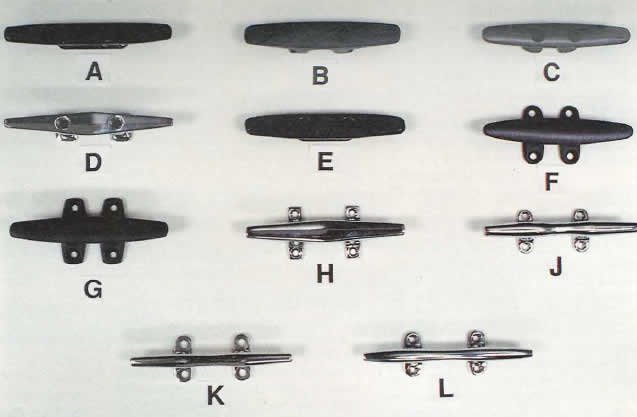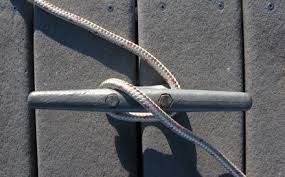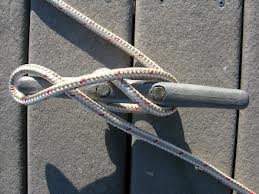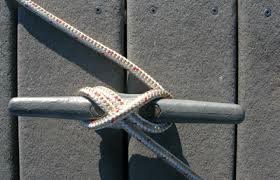Feet Don't Fail Me Now!
Foundation Findings #16 - Circa 1990
You've heard the expression, "only as strong as the weakest link." And so it is with cleats. Whether you're using a cleat for docking, mooring, towing a dinghy, or securing a halyard, it's important to think of the cleat as only a single part of an entire system (and not necessarily the most important part of the system).
The entire system consists of the cleat, the fasteners-including nuts, bolts and washers, the deck or other mounting platform, backing plates-and the line. You rely on that system to keep your boat secure, even in conditions like storms or towing that subject the system to tremendous stress and shock loads.
In this test, the BoatUS Foundation wanted to examine one of the most critical links in the system: cleats. Working in conjunction with the University of Virginia School of Engineering, we set up laboratory testing apparatus to simulate the loads placed on cleats of different design configurations and materials. Our goal was to determine the direction and magnitude of the smallest force required to deform or break a cleat fixed to a rigid surface with mounting hardware specified by the manufacturer.
Cleat Types & Failure Loads
| Test Cleat | Cleat Material | Fasteners | 0° | 45° | 90° | 45°/45° | Average Load Sustained | List Price (circa 1990) |
|---|---|---|---|---|---|---|---|---|
| A | Nylon | 2 - #10-32 | 2780 | 1390 | 1590 | 2380 | 2035 | $4.25 |
| B | Aluminum | 2 -1/4-20 | 3780 | 3860 | 3800 | 4000 | 3860 | $16.95 |
| C | Aluminum | 2 - 1/4-20 | 2500 | 3890 | 3700 | 4770 | 3715 | $36.35 |
| D | Zinc | 2 - 1/4-20 | 3580 | 3380 | 3970 | 4760 | 3928 | $21.00/pr. |
| E | Aluminum | 2 - 1/4-20 | 4970 | 3780 | 4170 | 5360 | 4570 | $19.25 |
| F | Aluminum | 4 - 1/4-20 | 4170 | 1190 | 1790 | 4770 | 2980 | $31.95 |
| G | Marinium | 4 - 1/4-20 | 7160 | 6760 | 6720 | 5370 | 6503 | $17.95 |
| H | Zamac | 4 - #10-32 | 3380 | 2920 | 2380 | 3180 | 2965 | $15.00/pr |
| J | Zinc | 4 - #10-32 | 3180 | 2780 | 2880 | 3970 | 3202 | $10.45 |
| K | Stainless | 4 - 1/4-20 | 6660 | 6800 | 7550 | 6560 | 6893 | $10.09 |
| L | Bronze | 4 - #10-32 | 3180 | 3990 | 3970 | 4570 | 3928 | $12.69 |
Test Procedures
The Foundation tested 11 six inch cleats made of nylon, aluminum, marinium (a magnesium-aluminum- titanium-beryllium alloy), chrome-plated zinc, bronze, stainless steel, and Zamac (a high-grade die-cast zinc alloy). Five of the cleats were two-hole; six were four-hole. The cleats were mounted on a 3/8- 6 inch thick steel plate in a tensile test machine. Admittedly, the steel plate is not the same as a deck mounting on a boat, but it prevents the fasteners from pulling out, and it eliminates different boat decking materials as a variable, so that only the cleat itself is being tested. To ensure uniformity, the cleats were mounted to the steel plate using manufacturer recommended sizes of flathead stainless steel bolts, nuts and washers, all tightened to precisely the same torque. The tensile strength of the bolts was also tested; they fell consistently within the manufacturer-listed range of 80,000 psi ( +/-10%).
Using a 3/8-inch diameter plastic- coated steel cable around each cleat, we pulled at four angles, as shown in the diagram below. (Plastic- coated cable was used to ensure that the cause of a failure would not be the rope or a weak point caused by wire abrading the cleat.) The first three pulls were parallel to the base, at 0°, 45° and 90° relative to the cleat's axis. The fourth pull was an upward 45°/45° pull, with the cable around both legs, pulling at 45° vertical and 45° forward.

The test was conducted under strictly controlled laboratory conditions. We suspect, however, that different tests might produce slightly different results, because the failure figures in each pull are dependent on so many variables.
For example, the seating of the fasteners relative to the exact center of the holes in the feet has a direct effect on load distribution and consequently the amount of stress placed on any given part of the cleat. Similarly, using a larger size line may produce different results, because larger line exerts more force on the bottom of the horn and less on the top of the leg. It is reassuring, however, that the results of this test coincide in most respects with those of a similar cleat test conducted by a manufacturer several years ago.
Test Results
The cleat assemblies withstood simple tension loads of between 1,190 and 7,500 lbs. before a failure occurred. The lower figure is roughly equivalent to the load a 40-ft. boat exerts on its working anchor under normal conditions. The cleat assemblies failed in one of four ways: fasteners, feet, legs, or the body of the cleat. The vast majority of failures, (57%) were fastener failures. Feet failure, exclusive to four-hole cleats, and to zinc and aluminum cleats in particular, was second at 23%. Bodies failed 14% of the time, and legs failed only 9%.

Fastener failures occurred with equal frequency at all three angles of pull parallel to the base (0°, 45° and 90°). By contrast, at the 45°/45° vertical angle pull, fastener failures accounted for less than half; the body of the cleat or its feet were more likely to fail first when pulled forward and up. However, in general the cleats withstood greater loads at this 45° upward pull than under straight pulls (the only two exceptions were the stainless steel cleat and the marinium cleat). Because fastener failure predominated, it may be inaccurate to assess cleat strength based solely on the loads applied. When the four loads each assembly withstood before failure are averaged, the stainless steel cleat assembly withstood the greatest loads, followed by the four-hole hollow marinium cleat. Not surprisingly, the nylon cleat ranked last, but it was stronger than we expected — it took a respectable 2,380 lbs. at 45° to cause the body to fail.
Two Holes or Four?
The test revealed that cleat design is at least as important as cleat material in affecting what breaks, and at what loads. Four-hole cleats were more likely to suffer failure of the feet, legs or body, while two-hole cleats suffered fastener failures 19 out of 20 times. We believe this is because the bolts in two-hole cleats are fastened directly through the center of the cleat, adding strength to the entire assembly. It seems the load applied perpendicular to the axis of the bolts in two-hole cleats causes the fasteners to shear off at the base.

With four-hole cleats, feet failed 10 times in 24 pulls (42%). The feet failed consistently on half the four hole cleats, and they failed under smaller loads than every other cleat except the nylon. Of these three four hole cleats with consistent foot failures, one was aluminum, one zinc and one Zamac. Since these three metals have identical tensile strengths and held their own in the two-hole category, there had to be another explanation. We found the answer in foot surface area: the three cleats with consistently failing feet had the three smallest foot surface areas of the six four-hole cleats we tested.
We took a closer look at the effect of foot surface area by comparing the very similar aluminum and marini urn four hole cleats (see · cleats F and G at right). The feet on the aluminum-a big, beefy cleat failed on all four pulls. The marinium cleat had no feet failures. It had twice the foot surface area of the aluminum cleat (0.13 inches2 vs. 0.07 inches2), and withstood more than twice the load of the aluminum cleat.So, we deduced, the design of the feet , particularly their surface area, is critical. Ironically, the weak-footed aluminum cleat was the most expensive of the 11 cleats we tested.
Conclusions
Although stainless steel has the greatest tensile strength of a ll the cleat materials we tested (double the tensile strength of aluminum, zinc, Zamac and marinium), it is nowhere near the most expensive cleat material, nor does it necessarily produce the strongest cleat in a given application. This is because, as mentioned earlier, a cleat is only one part of a system, and that system is only as strong as its weakest link.
Line is another part of the system. Generally, manufacturers recommend just slightly under one inch of cleat for every 1/16-inch of line diameter , which means you need a six-inch cleat for 3/8-inch line, an eight-inch cleat for 1/2-inch line, and a 10-inch cleat for 5/8-inch line. Using larger cleats for larger lines adds both weight and expense, but what would be the point of using 3/8-inch nylon line, with a breaking strength ocleat you attach it to can't withstand the same or greater load?
Chafe plays a vital role in the security of any cleat system. You can reduce chafe by using larger cleats, or cleats with smooth, round legs and no sharp angles, since the strength of a line is reduced by bending fatigue when it has to turn sharp corners or make tight bends. Mount your chocks as close to the cleats as possible, and avoid changing the direction of the rope along its path through the chock to the cleat.
As a rule, you should buy the largest size cleat your pocketbook and the deck space can handle. Choose one made of a high tensile strength material, like stainless steel , bronze, aluminum or marinium. Examine the feet to make sure they are large relative to the size of the cleat, sturdy, and have an ample thickness of metal around the fastener holes.



Marinium usually costs slightly more than aluminum. Both metals have the same tensile strength, but marinium has a higher strength-to-weight ratio. The marinium cleat held up better in our tests, performing almost as well as the stainless. Zinc and nylon have the least tensile strength, and are the least expensive. But with zinc, as with aluminum and marinium, be aware of the potential for galvanic corrosion if you use fasteners of dissimilar metals (like stainless) in a saltwater environment. Nylon or plastic cleats are fine for small boat rigging, flags and other low-load applications, but for moorings, docking, and ot her uses that involve the security of your boat, stick to the stronger metals. Best buys on our test list are the four-hole stainless, marinium and bronze six-inch cleats, and the two hole aluminum cleat (B) at $16.95.
To deck-mount a high-load fitting like a cleat so that it's really sound and water tight, first strengthen the system by reinforcing the base. Use an under-deck pad twice the length of the cleat and one half cleat length across. On deck, use a pad about 25% longer and wider than the cleat. Use only stainless steel or bronze bolts (not screws) as recommended by the manufacturer, and stainless washers under the nuts to spread the load.
Avoid locating cleats on soft-core surfaces like balsa-core. If it 's unavoidable, then the core material must be removed and reinforced before installation, a job that's generally best left to a professional.

